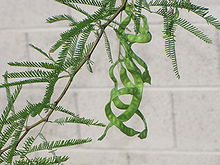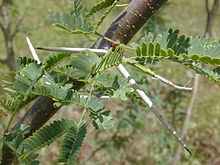- Mesquite
-
For other uses, see Mesquite (disambiguation).
Mesquite (from Nahuatl mizquitl) is a leguminous plant of the Prosopis genus found in northern Mexico through the Sonoran Desert and Chihuahuan Deserts, and up into the Southwestern United States as far north as southern Kansas, west to the Colorado Desert in California,and east to the eastern fifth of Texas, where average annual rainfall is in excess of 40 inches (100 cm). Several species are found in arid to semi-arid regions of southern and western South America.It goes 30 feet into the ground.
Contents
Description
 Legumes of the Chilean mesquite (Prosopis chilensis)
Legumes of the Chilean mesquite (Prosopis chilensis)
These deciduous trees can reach a height of 6 to 9 m (20 to 30 ft) although in most of their range they are shrub size. They have narrow, bipinnately compound leaves 50 to 75 mm (2 to 3 in) long, of which the pinnules are sharply pointed. Twigs have a characteristic zig-zag form. Some common species of mesquite are honey mesquite (Prosopis glandulosa), velvet mesquite (Prosopis velutina), creeping mesquite (Prosopis strombulifera), and screwbean mesquite (Prosopis pubescens).
Mesquite is an extremely hardy, drought-tolerant plant because it can draw water from the water table through its long taproot (recorded at up to 190 ft {58 m} depth). It can also use water in the upper part of the ground, depending upon availability. The tree can easily and rapidly switch from using one water source to the other.
Many people, especially ranchers, consider the tree a nuisance because it competes with rangeland grasses for moisture. In many parts of Texas, particularly West and Central Texas, the proliferation of mesquite is blamed for lowering of groundwater tables.[1] However, salt cedar has had a greater effect on water consumption in riparian areas, in some cases even displacing existing mesquite.[2][3]
 Thorns of Prosopis pallida
Thorns of Prosopis pallida
Eradicating mesquite is difficult because the plant's bud regeneration zone can extend down to 6 inches (150 mm) below ground level;[4][5] the tree can regenerate from a piece of root left in the soil.[4] Some herbicides are not effective or only partially effective against mesquite. Grubbing techniques for removal, while effective against short-term regrowth, are expensive, costing upwards of $70/acre ($17,000/km²).
New growth of mesquite has needle-sharp thorns up to 75 mm (3 in) long. The spines are tough enough to penetrate the soft soles of sneakers or similar footwear, and can easily puncture tires.
Ecology and Ethnobotany
Bee forage
The tree's flowers provide a nectar source for bees to produce mesquite honey (monofloral honey), which has a characteristic flavor.
Environment
Mesquite trees grow quickly and furnish shade and wildlife habitat where other trees will not grow. Being a legume, it fixes nitrogen in the soil where it grows, although this is rather newly discovered and is still a poorly understood part of its life cycle.[6]
Food
The bean pods of the mesquite can be dried and ground into flour, adding a sweet, nutty taste to breads, or used to make jelly or wine.
When used in baking, the mesquite bean flour is used in combination with other flours – substitute ¼ cup-to-½ cup mesquite flour in each cup grain flour. Mesquite bean flour is used in breads, pancakes, muffins, cakes and even cookies. Mesquite powder is also high in calcium, magnesium, potassium, iron and zinc, and is rich in the amino acid lysine.[7]
Wild animals also eat mesquite bean pods. In places like Death Valley and much of the Sonoran Desert coyote feces consisting almost entirely of mesquite beans and pods can often be seen[clarification needed].
Traditional medicine
Mesquite leaves were once used medicinally; water infused with the leaves can be used as eye drops.[citation needed]
Cultivation
Several Prosopis species and cultivars are cultivated in the horticulture trade as an ornamental tree for native plant, drought tolerant, and habitat gardens, and also various types of municipal and commercial landscape projects.
Wood
Mesquite wood is hard, allowing it to be used for furniture and implements. Wood from Prosopis juliflora and Prosopis glandulosa is used for decorative woodworking and woodturning. It is highly desirable due to its dimensional stability after being fully cured. The hard, dense lumber is also sold as "Texas Ironwood" and is rather harsh on chain saws and other tools.
As firewood, mesquite burns slowly and very hot. When used to barbecue, the smoke from the wood adds a distinct flavor to the food. This is common in the Southwest and Texas-style barbecue.
Mesquite-wood roasting or grilling is used to smoke-flavor steaks, chicken, pork, and fish. Mesquite smoke flavoring can be added to vegetable stir-fries, scrambled eggs, soups, and even ice cream.
As an introduced species
The species Prosopis pallida was introduced to Hawaii in 1828 and is now very common in the drier coastal parts of the islands, where it is called the kiawe tree, which is a prime source of monofloral honey production.[8]
Mesquite has also been introduced to parts of Africa,[9] Asia and Australia and is considered by the World Conservation Union as one of the world's most problematic invasive species.[10]
Species
- Prosopis alba
- Prosopis glandulosa (honey mesquite)
- Prosopis nigra
- Prosopis pallida
- Prosopis pubescens (screwbean mesquite)
- Prosopis reptans (tornillo)
- Prosopis strombulifera (creeping mesquite)
- Prosopis velutina (velvet mesquite)
See also
References
- ^ Discussion at the Stakeholder Advisory Forum for the Southern Gulf Coast aquifer Groundwater Availability Model
- ^ Salt Cedar: A Noxious Weed
- ^ issg Database: Ecology of Tamarix ramosissima
- ^ a b Mesquite Info
- ^ The Mesquite
- ^ Ecological Consequences of Mesquite Fixation of Nitrogen
- ^ Amsden, M. (2006) RAWvolution: Gourmet Living Cuisine. HarperCollins Publishing. Retrieved on August 30, 2009.
- ^ Prosopis pallida species info
- ^ Information resources, including Tropical agriculture publications
- ^ "100 of the World's Worst Invasive Alien Species". http://www.k-state.edu/withlab/consbiol/IUCN_invaders.pdf. Retrieved 2009-11-27.
External links
- USDA NRCS Plants Database
- Honey mesquite, Screwbean mesquite, and Western mesquite at Texas A&M's Plant Answers
- Honey mesquite at the Texas Tree Planting Guide
- AgNews article on wood to ethanol using mesquite
- Mesquite Furniture Maker Directory
- Mesquite Roasted Coffee web site devoted to mesquite wood fire roasting of coffee
- Mesquite Local Business Directory
- Rogers, Ken E. (2000). The Magnificent Mesquite. University of Texas Press. ISBN 0292771053. OCLC 43036762.
Categories:- Prosopis
- North American desert flora
- Garden plants of North America
- Ornamental trees
- Drought-tolerant trees
- Honey plants
- Edible legumes
- Ark of Taste foods
Wikimedia Foundation. 2010.

